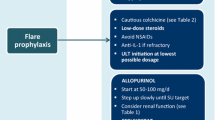Abstract
Hyperuricemia and gout are common complications in adult renal transplant recipients. In pediatric recipients, however, hyperuricemia seems to be rare, but data are scarce. Thirty-two children (21 males, 11 females) were investigated for a median time of 4.8 years (range: 0.4–11.2 years) following renal transplantation. The median age of this pediatric study group was 13.9 years (range: 5.7–20.3 years), and the calculated glomerular filtration rate (GFR) was 61 ml/min per 1.73 m2 (range:12–88 ml/min per 1.73 m2). All patients were given calcineurin inhibitors, with 22 and ten children receiving cyclosporine A (CSA) and tacrolimus (TAC), respectively. The median plasma uric acid was 385 μmol/l (range: 62–929 μmol/l); 15 children (47%) were above the age-related normal range. Only one patient experienced gouty arthritis. There was a significant correlation between plasma uric acid concentration and both time span after transplantation and plasma creatinine, and an inverse correlation to GFR (p<0.05). No significant correlation was found between plasma uric acid and body mass index (BMI). Plasma uric acid concentrations were neither different among CSA- and TAC-treated children, nor did they correlate with drug exposure or blood trough levels of CSA or TAC. Plasma uric acid concentration was not different when compared to children with chronic renal failure (CRF) of a similar degree in native kidneys. We conclude that hyperuricemia is common among pediatric renal transplant recipients and rather a consequence of chronic renal transplant dysfunction than the use of calcineurin inhibitors. Gout, however, is rare.


Similar content being viewed by others
References
Clive DM (2000) Renal transplant-associated hyperuricemia and gout. J Am Soc Nephrol 11:974–979
Delaney V, Sumrani N, Daskalakis P, Hong JH, Sommer BG (1992) Hyperuricemia and gout in renal allograft recipients. Transplant Proc 24:1773–1774
Neal DA, Tom BD, Gimson AE, Gibbs P, Alexander GJ (2001) Hyperuricemia, gout and renal function after liver transplantation. Transplantation 72:1689–1691
Burack DA, Griffith BP, Thompson ME, Kahl LE (1992) Hyperuricemia and gout among heart transplant recipients receiving cyclosporine. Am J Med 92:141–146
Edvardsson VO, Kaiser BA, Polinsky MS, Palmer JA, Quien R, Baluarte HJ (1995) Natural history and etiology of hyperuricemia following pediatric renal transplantation. Pediatr Nephrol 9:57–60
Baldree LA, Stapleton FB (1990) Uric acid metabolism. Pediatr Clin North Am 37:391–418
Invitti C, Guzzaloni G, Gilardini L, Morabito, Viberti G, (2003) Prevalence and concomitants of glucose intolerance in European children and adolescents. Diabetes Care 26:118–124
Denzer C, Muche R, Mayer H, Heinze E, Debatin KM, Wabitsch M (2003) Serum uric acid levels in obese children and adolescents: linkage to testosterone levels and pre-metabolic syndrome. J Pediatr Endocrinol Metab 16:1225–1232
Hoyer PF, Lee IJ, Oemar BS, Krohn HP, Offner G, Brodehl J (1988) Renal handling of uric acid under cyclosporin A treatment. Pediatr Nephrol 2:18–21
Pela I, Seracini D, Lavoratti G, Materassi M (1999) Acute gouty arthritis in adolescents with renal transplants. Ped Med Chir 21:135–137
Schwartz GJ, Haycock GB, Edelmann CM Jr, Spitzer A (1976) A simple estimate of glomerular filtration rate in children derived from body length and plasma creatinine. Pediatrics 58:259–263
Prader A, Largo RH, Molinari L, Issler C (1989) Physical growth of Swiss children from birth to 20 years of age. First Zurich longitudinal study of growth and development. Helv Paediatr Acta Suppl 52:1–125
Marcén R, Gallego N, Orofino L, Gamez C, Estepa MR, Sabater J, Teruel JL, Ortuno J (1995) Impairment of tubular secretion of urate in renal transplant patients on cyclosporine. Nephron 70:307–313
Noordzij TC, Leunissen KM, Van Hooff JP (1991) Renal handling of urate and the incidence of gouty arthritis during cyclosporine and diuretic use. Transplantation 52:64–67
Hansen JM, Fogh-Andersen N, Leyssac PP, Strandsgaard S (1998) Glomerular and tubular function in renal transplant patients treated with and without cyclosporine A. Nephron 80:450–457
Braun WE, Richmond BJ, Protiva RW, Gifford RW Jr, Straffon RA (1999) The incidence and management of osteoporosis, gout and avascular necrosis in recipients of renal allograft functioning more than 20 years treated with prednisone and azathioprine. Transplant Proc 31:1366–1369
Laine J, Holmberg C (1996) Mechanism of hyperuricemia in cyclosporine-treated renal transplanted children. Nephron 74:318–323
Ochiai T, Ishibashi M, Fukao K, Takahashi K, Endo T, Yokoyama I, Uchida K, Ohshima S, Takahara S, Morozumi K, Yamaguchi Y, Kyo M, Sonoda T, Takagi H, Ota K, Iwasaki Y, and the Japanese FK 506 Study Group (1995) Japanese multicenter studies of FK 506 in renal transplantation. Transplant Proc 27:50–53
Pilmore HL, Faire B, Dittmer I (2001) Tacrolimus for treatment of gout in renal transplantation: two case reports and review of the literature. Transplantation 72:1703–1705
Shibolet O, Elinav E, Ilan Y, Safadi R, Ashur Y, Eid A, Zamir G, Fridlander M, Bdolah-Abram T, Shouval D, Admon D (2004) Reduced incidence of hyperuricemia, gout, and renal failure following liver transplantation in comparison to heart transplantation: a long-term follow-up study. Transplantation 77:1576–1580
Kanbay M, Akcay A, Huddam B, Usluogullari CA, Arat Z, Ozdemir FN, Haberal M (2005) Influence of cyclosporine and tacrolimus on serum uric acid levels in stable kidney transplant recipients. Transplant Proc 37:3119–3120
West C, Carpenter BJ, Hakala TR (1987) The incidence of gout in renal transplantation. Am J Kidney Dis 10:369–372
Venkat RG, Sharman VL, Lee HA (1990) Azathioprine and allopurinol: a potential dangerous combination. J Intern Med 228:69–71
Reyes AJ (2003) Cardiovascular drugs and serum uric acid. Cardiovasc Drugs Ther 17:397–414
Schlesinger N (2005) Dietary factors and hyperuricemia. Curr Pharm Design 11:4133–4138
Gerhardt U, Hüttmann M, Hohage H (1999) Influence of hyperglycemia and hyperuricemia on long term transplant survival in kidney transplant recipients. Clin Transplant 13:375–379
Mazzali M, Kim YG, Suga S, Gordon KL, Kang DH, Jefferson JA, Hughes J, Kivlighn SD, Lan HY, Johnson RJ (2001) Hyperuricemia exacerbates chronic cyclosporine nephropathy. Transplantation 71:900–905
Author information
Authors and Affiliations
Corresponding author
Rights and permissions
About this article
Cite this article
Spartà, G., Kemper, M.J. & Neuhaus, T.J. Hyperuricemia and gout following pediatric renal transplantation. Pediatr Nephrol 21, 1884–1888 (2006). https://doi.org/10.1007/s00467-006-0257-5
Received:
Revised:
Accepted:
Published:
Issue Date:
DOI: https://doi.org/10.1007/s00467-006-0257-5




